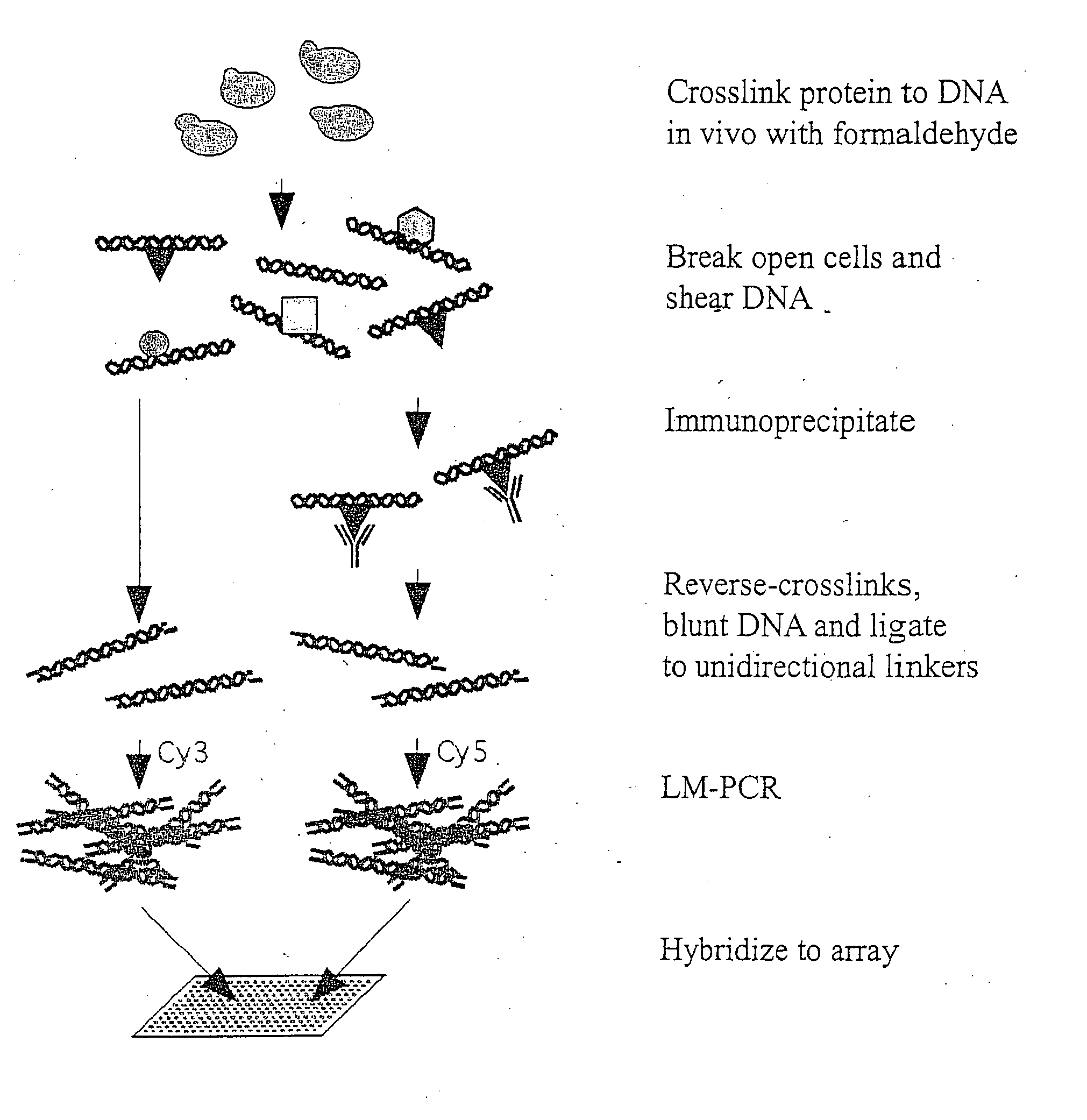Genome wide location and function of DNA binding proteins
a technology genomes, applied in the field of genome wide location and function of dna binding proteins, can solve the problems of limited knowledge of the binding sites of these proteins in the genome, and achieve the effect of facilitating the dissection of the cell regulatory network and facilitating identification
- Summary
- Abstract
- Description
- Claims
- Application Information
AI Technical Summary
Benefits of technology
Problems solved by technology
Method used
Image
Examples
example 1
Design of Yeast Chromosome III and Selected Model Genes Array for the Characterization of Protein-DNA Interactions
[0070] Array contains all non-overlapping open reading frames (ORF) on Chromosome III (See Table 1). When a sequence contains part or all of two potential reading frames, the larger sequence was chosen to represent the ORF. Any remaining sequence was included in intergenic fragments.
[0071] All intergenic regions larger than 100 bp are represented by fragments averaging 500 bp. Where regions are greater than 700 bp, they are broken into multiple fragments of 300 to 600 bps. PCR primers for each region were chosen using the Saccharomyces Genomic Database (SGD) “Design Primers” program from Stanford University. The total number of intergenic fragments equals 241 for Chromosome III.
[0072] The location and size of open reading frames were determined from the Saccharomyces Genomic Database (SGD) functional chromosomal map.
[0073] An additional 17 model genes (see the Table)...
example 2
Genome-Wide Location and Function of DNA-Binding Proteins
Global Analysis of Gal4 Binding Sites
[0104] To investigate the accuracy of the genome-wide location analysis method, the analysis was used to identify sites bound by the transcriptional activator Gal 4 in the yeast genome. Gal 4 was selected because it is among the best characterized transcriptional activators, it is known to be responsible for induction of genes necessary for galactose metabolism, and a consensus DNA binding sequence (the UASG) has been identified for Gal4 in the promoters of the GAL genes. Very little Gal 4 is bound at the UASG of the GAL1 and GAL10 promoters when cells are grown in glucose (the repressed state), whereas relatively high levels of Gal4 are bound in galactose (the activated state).
[0105] The genome-wide location of epitope-tagged Gal 4p in both glucose and galactose media was investigated in three independent experiments, as described in more detail below. The location analysis experiment ...
example 3
Serial Regulation of Transcriptional Regulators in the Yeast Cell Cycle
Experimental Procedures
Tagging and Yeast Strains
[0121] The cell cycle activators Swi4, Mbp1, Swi5, Fkh1, Fkh2, Ndd1 Mcm1, and Ace2 were tagged with a multicopy myc epitope by inserting the epitope coding sequence into the normal chromosomal loci of these genes. Vectors developed by Cosma et al. Cell, 97:299-311 (1998) were used for amplifying a fragment that contains the repeated myc tag coding sequence flanked by 50 bp from both sides of the stop codon of the gene. The PCR products were transformed into the W303 strain Z1258 (MATα, ada2-1, lrp1-1, can1-100, leu2-3, 112, his3-11, 15, ura3) to generate the tagged strains (Z1335, Z1372, Z1373, Z1446, Z1370, Z1369, Z1321, and Z1371, respectively). Clones were selected for growth on TRP plates, the insertion of the tagged sequence was confirmed by PCR, and expression of the epitope-tagged protein was confirmed by Western blotting using an anti-Myc antibody (9E11...
PUM
| Property | Measurement | Unit |
|---|---|---|
| concentration | aaaaa | aaaaa |
| pH | aaaaa | aaaaa |
| volume | aaaaa | aaaaa |
Abstract
Description
Claims
Application Information
 Login to View More
Login to View More - R&D
- Intellectual Property
- Life Sciences
- Materials
- Tech Scout
- Unparalleled Data Quality
- Higher Quality Content
- 60% Fewer Hallucinations
Browse by: Latest US Patents, China's latest patents, Technical Efficacy Thesaurus, Application Domain, Technology Topic, Popular Technical Reports.
© 2025 PatSnap. All rights reserved.Legal|Privacy policy|Modern Slavery Act Transparency Statement|Sitemap|About US| Contact US: help@patsnap.com



